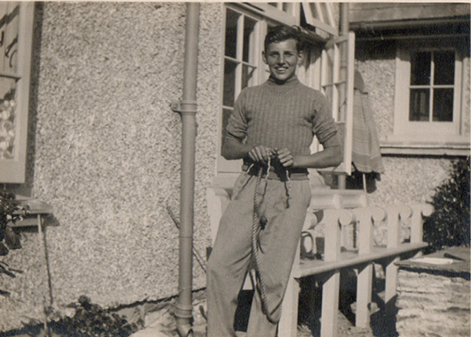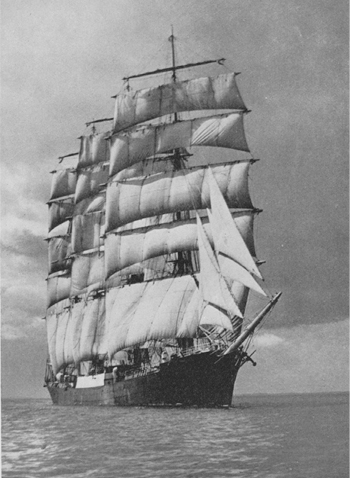
Полная версия
The Last Grain Race
When the tables were cleared the Managing Director had risen to his feet. He was shiny and palm-beach-suited. In office hours he was disagreeable; now, filled with wary bonhomie, he was unspeakable. He began his speech by referring to us as ‘Boys and Girls’, at which a premonitory and quite audible shudder ran through the assembly. He went on to regret the absence of Mr Wurzel, our Chairman, who had unexpectedly been called away. Although, he said, we had made progress in the last year, we might have to draw in our horns and retrench in the very near future.
After what seemed a lifetime, the Managing Director reached the final peroration: ‘What I always feel,’ he said, ‘is that we’re just one big happy family.’ He then sat down to a round of rather limited applause.
Now, in the grey morning, the party was over and the happy family was breaking up fast. In Layout and Ideas packing was going on with end-of-term abandon. The illusion was heightened by Julian Pringle, an enormous creature dressed in a green jacket of primitive homespun and a flaming tomato tie. He was sitting on his desk chanting ‘No more Latin, no more French’ whilst he tied up a great parcel of Left Book Club editions. This was nothing to him. Ideas men lived the uneasy life of King’s favourites, and if not discharged would very often take themselves off to another agency, sometimes with a client in tow. At nine-thirty this morning Julian had already been in touch with a well-known rival to Wurzel’s, who was glad to have him.
Before Robbie left I asked him why I had not been sacked with the rest of them. Robbie only called you ‘old boy’ in moments of stress. He was reluctant to answer my question. He called me ‘old boy’ now.
‘Well, old boy, they did think about it but they decided that it cost them so little that it didn’t make any difference whether you stayed or not.’
I was furious. The Porter had been wrong and I hadn’t ‘’ad it.’ I was perhaps the only member of the staff who would have actively welcomed the sack. Wurzel’s was a prison to me. All the way home in the Underground I seethed… too unimportant to be sacked…. At Piccadilly the train was full but the guards packed in more and more people. At Knightsbridge two of them tried to force an inoffensive little man into the train by putting their shoulders to the back of his head and shoving. Someone began to Baa loudly and hysterically. There was an embarrassed silence and nobody laughed. We were all too much like real sheep to find it funny.
At Hammersmith, where I emerged sticky and wretched from the train, I found that we had been so closely packed that somebody had taken my handkerchief out of my pocket, used it, and put it back under the impression that it was his own.
I bought an evening paper. It had some very depressing headlines about the breakdown of Runciman’s negotiations at Prague.
The next day I went to Salcombe for my holiday. During that fortnight while swimming in Starehole Bay I dived down and saw beneath me the remains of the four-masted barque Herzogin Cecilie lying broken-backed, half buried in the sand.
On my way back to London there was an hour to wait for the connection at Newton Abbot, and wandering up the hot and empty street in the afternoon sunshine I went into a café and wrote to Gustav Erikson of Mariehamn for a place on one of his grain ships.
I never went back to Wurzel’s.
2
Mountstewart

Young Eric Newby
The sea had always attracted me. I had inherited my enthusiasm from my father, who had once tried to run away to sea and had been brought back from Millwall in a hackney cab. He had not repeated the attempt but ever since, the sound of a ship’s siren or the proximity of a great harbour would unsettle him. He was, and still is, the sort of man who would crush other people’s toes underfoot to look out of a crowded compartment as the train passed Southampton Water, simply to gain a fleeting glimpse of the liners berthed there. Seagulls wheeling over a ploughed field would bring the comment: ‘There must be dirty weather at sea to drive them so far inland.’
My interest in sailing ships was being constantly renewed by my visits to the house of a certain Mr Mountstewart whose daughter had been a great friend of mine ever since I could remember. Although Mr Mountstewart was not old-looking when I first met him at the age of six or seven, he could not have been particularly young even then. He had taken part in the Matabele War, the Jameson Raid and various other skirmishes. Buchan would have loved him. In fact, if he had known Mr Mountstewart he would probably have incorporated him in the Thirty-Nine Steps instead of Hannay, who always seemed to me to be a creature unduly favoured by fortune.
You could not imagine Mr Mountstewart needing luck or coincidence to help him, although he was by no means well off and would probably have welcomed the chance that Buchan gave his heroes to make their piles before returning to ‘The Old Country’. Later, when he lent me Erskine Childers’ Riddle of the Sands, I immediately identified him with Davies, that splendid sailor and enthusiastic patriot. It did not surprise me when I learnt that he had known Erskine Childers. To this day I am convinced that Mr Mountstewart was a member of the British Secret Service.
At some time towards the end of the eighties he had made a voyage from Calcutta to London in a clipper ship which carried skysails above the royals. His description of sitting astride the skysail yard, which was as thin as a broomstick and shook violently, filled me with apprehension. He had shipped as a passenger, lived aft and had had leisure for reading and speculation. His reminiscences were to prove highly misleading.
The study where he worked was extraordinary, and nothing like it can conceivably have existed outside the British Museum and those sections of the Royal College of Surgeons not accessible to the general public. On the wall facing the door was the longest muzzle-loading punt gun I had ever seen. Below it was a smaller model. Mr Mountstewart was a Fen man and still occasionally discharged this piece from a specially strengthened canoe. Both punt guns hung close up to the ceiling, I suspect, because they were loaded. Beneath them a shark’s head, its jaws agape, protruded from the wall. Next door was the bathroom; sometimes when I called, Mr Mountstewart would be having a bath, and the sounds coming from it made me think that it was the invisible hind parts of the shark happily threshing the water.
On the back of the door hung a spiked pickelhaube from a volunteer regiment that Mr Mountstewart had joined in some sudden emergency. On one side it was flanked by a narwhal’s tusk and on the other by the sword of a swordfish.
To the left of the door over the fireplace was an oil-painting of the skysail yarder outside Foochow. She was shown with her ports painted black and white, which according to him was supposed to discourage piracy in the China Sea. The picture was by a Chinese artist whose imagination had overburdened the vessel with canvas.
For the rest the room contained a fantastic medley; faded photographs of early submarines at Spithead and the first turbine vessel Turbina, filled with apprehensive-looking men in bowler hats roaring through a crowded anchorage; assegais and knobkerries; devil masks and kris; Martini-Henry rifles and bandoliers of soft-nosed bullets.
In a recess stood a large bookcase, the top shelf filled with bottles containing nasty things in pickle, including a foetus, of what species I never dared to ask, only hoping it wasn’t human. The second shelf contained a quantity of Nobel explosive and, within dangerous proximity, an electric exploder. The shelves below were filled with books of travel, charts, maps and text-books which instructed you how to behave in the most difficult circumstances. One of these, a work on first aid in extremis, contained the account of a North American trapper successfully amputating his leg with a bowie knife after an affray with Red Indians. It also contained instructions for setting a broken collar bone by hurling yourself backwards off a rock.
Near the window, in a polished brass shell-case of a Gatling gun, stood a sheaf of large rockets with metal sticks which served the same decorative purpose as the Pampas grass in the front window of the next house. One Fifth of November Mr Mountstewart had appeared in our garden by Hammersmith Bridge with a number of these rockets which he fired off in series in the direction of the poorer and more inflammable parts of Fulham. They had disappeared into the night with a satisfying scream, and I am quite certain did a large amount of damage. Mr Mountstewart always maintained they were life-saving rockets but it is more probable that they had been constructed for offensive purposes at the time of the Napoleonic Wars.
The following year he appeared with a spherical object called a Gerb which he insisted was a firework. The bomb, for that is what it proved to be, was lowered into a thick iron mortar which was supposed to be deeply embedded in the earth. Unfortunately, this was not carried out properly, as the gardens were the common property of the flats in which we lived and it was felt that the grass would be damaged. It would have been cheaper to damage the grass. The initial explosion jerked the mouth of the mortar into an upright position, and instead of going over the river the Gerb, like its modern counterpart the V-2, shot vertically into the air with increasing velocity. At eighty feet it should have exploded, but it failed to do so and began to descend on us with a tremendous whining sound. In spite of his age, Mr Mountstewart was farthest from the Gerb when it finally exploded, breaking a number of windows.
I do not think my parents approved of Mr Mountstewart. In any event they never mentioned his name and my visits to his house became more or less clandestine. There I first read Slocum’s Sailing Alone Round the World and Shackleton’s South, with its description of the journey in a small open boat in the Antarctic winter from Elephant Island to South Georgia, and the subsequent crossing of that island on foot which resulted in the rescue of the rest of the members of the expedition.
I always felt that Mr Mountstewart resembled the Seafaring Rat in The Wind in the Willows who persuades the Water Rat to renounce everything and go to sea. By the time I had been at Wurzel’s a year his plans for me were nearly coming to fruition. Not only had he succeeded in making me think of nothing but sailing ships; he had also made me feel that discomfort and worse were preferable to my present situation. We would be discussing some proposed voyage and the victuals required and he would bring out the South American Pilot (Part 2), which was full of passages like this:
Off Cape St. John, the eastern point of Staten Island, a heavy tide rip extends for a distance of five or six miles or even more, to seaward. When the wind is strong and opposed to the tidal stream the overfalls are overwhelming and very dangerous even to a large and well found vessel. Seamen must use every precaution to avoid this dangerous area.
A horrid picture of the Fuegian scene was conjured up by the following extract under ‘Refuge Station – Lifeboat’:
A refuge station has been established by the Argentine Government in this harbour (St. John), provided with a lifeboat for the assistance of shipwrecked mariners. A report made in 1911 states that there was only one inhabitant of Staten Island who had been left alone at Port Cook, in charge of some machinery for extracting fat from seals, for six years.
Mr Mountstewart’s strongest card in this game of getting me to sea was the one about time running out. For me time running out meant an outbreak of war, for him it meant waking one morning to find the seas stripped of four-masted barques. There were still in 1938 thirteen vessels entirely propelled by sail, engaged in carrying grain from South Australia to Europe by way of Cape Horn. There were other cargoes for these ships; timber from Finland to East Africa, guano (a sinister kind of bird dung) fom Mauritius and the Seychelles to New Zealand, and very rarely, for the two remaining German barques, cargoes of nitrate from Tocopilla, Mejillones and other ports on the Chilean Coast to be carried round the Horn to Hamburg. But for the most part the outward voyages from Europe to South Australia round the Cape of Good Hope and across the Southern Indian Ocean were ballast passages. Grain was the staple cargo. If that failed most of these thirteen ships would soon be rusting at forgotten anchorages.
The survival of the big sailing ships in this trade was due to several favourable circumstances. Grain was not dependent on season, neither was it perishable. In the primitive ports of the Spencer Gulf, where the grain was brought down from the back blocks in sacks, steamers found it difficult to load a cargo in an economical time. Although at some ports there were mile-long jetties, at most places the grain had to be brought alongside the ships in lightering ketches and slung into the hold with the vessel’s own gear, which might, and frequently did, take weeks. But a sailing ship run with utmost economy and a low-paid crew could still in 1938 take six weeks to load her cargo of 4,000 tons of grain, reach Falmouth or Queenstown for orders after 120 days on passage and still make a profit on a round voyage of about 30,000 miles, the outward 15,000 having been made in ballast.
3
Fitting Out

Moshulu, Belfast Lough, September 1938
When I returned from my holiday, events started to happen with increasing momentum so that I began to feel like the central figure in one of those films of the twenties, in which the actors flash in and out of buildings in the twinkling of an eye. With suspicious promptness a letter arrived from Gustav Erikson in Mariehamn, in which that man of iron told me to get in touch with his London Agents, Messrs. H. Clarkson of Bishopsgate.
Captain Gustav Erikson of Mariehamn, ‘Ploddy Gustav’ as he was known more or less affectionately by the men and boys who sailed his ships, was in 1938 the owner of the largest fleet of square-rigged deep-water sailing vessels in the world. The great French sailing fleet of Dom Borde Fils of Bordeaux had melted away upon the withdrawal of government subsidies in the twenties; only two barques, Padua and Priwall, still belonged to the once great house of Laeisz of Hamburg; Erikson remained. He was not only the proprietor of twelve four- and three-masted barques, he also owned a number of wooden barquentines and schooners, the majority of which were engaged in the ‘onker’ (timber trade) in the Baltic and across the North Sea.
At the time I went to sea he was sixty-five years old. Unlike most twentieth-century shipowners he had been a sailor with wide practical experience before he had become a shipowner. At the age of nine he had shipped as a boy aboard a vessel engaged in the North Sea trade. Ten years later he had his first command in the same traffic and then, for six years, he had shipped as mate in ocean-going ships. Between 1902 and 1913, when he finally left the sea to concentrate on being an owner, he was master of a number of square-rigged vessels.
If I had imagined that Clarkson’s would be impressed when I approached them, I should have been disappointed. I was one of a number of Englishmen who applied to join the Grain Fleet every year, and Clarkson’s could not know that I was to be one of the last. From this small mahogany-bound office, saved from being prosaic by the numerous pictures of sailing ships on the walls, they looked after the destinies of practically every grain sailer in the world. Even the Germans came to Clarkson. In 1937 they fixed the high freight of 42s 6d a ton for the Kommodore Johnsen. Most cargoes were for British ports and Clarkson fixed the freights. Erikson was well served by them.
I learned some of these things from a little white-haired man, who said that to make the voyage at all I must be bound apprentice and pay a premium of fifty pounds. He made no suggestions except that I would probably be better advised not to go at all. I left Bishopsgate with a form of indenture which among other provisions stipulated that my parents were to bind me to the owner for eighteen months or a round voyage; that if I deserted the ship in any foreign port my premium would be forfeited; that if I died or became incapacitated, a pro-rata repayment of premium could be claimed; that I should receive 120 Fin-marks (10s) a month, and that I should be subject to Finnish law and custom.
This document my father reluctantly signed after hopelessly trying to discover something about Finnish law and custom. I remember that he was particularly concerned to find out whether the death penalty was still enforced and in what manner it was carried out. Even more reluctantly he paid out £50 and sent off the Indentures with two doctors’ certificates attesting that I was robust enough for the voyage, and one from a clergyman which stated that I was of good moral character. By this time I began to feel that I was destined for Roedean rather than the fo’c’sle of a barque.
During this time Mr Mountstewart had not been inactive. For him the balloon had gone up, this was what he had been waiting for. In the language of his generation it was ‘Der Tag’. With memories of long periods of inactivity in the skysail yarder, he had got into touch with an acquaintance of his, a fashionable ship’s chandler, whose interest lay principally in the fitting out of yachts in the Solent and the Hamble River. Between them they had drawn up a formidable list of books on navigation and seamanship which I would peruse under the direction of the Master. This was a heaven-sent opportunity for Mr Mountstewart’s friend, and he was not backward in loading me with his wares, which included a particularly repellent kind of sea-water soap. I staggered from his showrooms to a taxi with a great pile of logarithm tables, nautical almanacs and seaman’s manuals, all slightly shop-soiled. He had tried to persuade me that I needed a sextant but a premonitory and for once accurate voice told me that where I was going I might find difficulty in living it down.
His conscience had not allowed him to recommend his ‘yachting’ brand of oilskins and clothing, and he had sent me off to the East India Dock Road where I might obtain more suitable garments than his own, which were no doubt excellent for the purpose for which they were designed. Perhaps he knew more than I imagined about sailing ships and feared that I might return after the voyage to accuse him of selling oilskins that split.
When the manager of the store in the East India Dock Road heard who had sent me and what I was proposing to do, he decided to give me his personal attention. He was far grander and more sure of himself than the neighbourhood in which the outfitters was situated would have led me to expect. The complete outfitting of a hundred shipwrecked lascars would have been nothing to him. I was a smallish order and he proposed to deal with me accordingly. He swept me down the staircase to the basement past rails of hideous shore-going suits. ‘Now, sir,’ he said, taking a deep and well-practised breath, ‘you will be wanting pilot coat heavy trousers two suits working clothes heavy underwear heavy seaboots long oilskin coat oilskin trousers sea-boot stockings stormcap knife and spike, mattress straw.’
It was a hot September day. I put on the long thick vest and underpants; like all their counterparts in England they were supported mysteriously by a number of tapes which once tied in a knot could never be undone but had to be severed. Over these foundation garments I put layers of unseasonable clothing: thick navy working shirts and trousers of itchy cloth, a seaman’s jersey, stockings and seaboots. Over these went the oilskin coat and trousers, the latter insecurely supported by a single cord. On my head was the storm cap. Even this was disappointing: it was made of patent leather trimmed with imitation Astrakhan. There were flaps that let down over the ears or could be tied up on top of the hat like a deerstalker. Everything was unnecessarily ugly.
The manager was delighted at my transformation. ‘Now, sir,’ he said briskly, ‘if you would like to move about a little…’ I walked a few feet to get what he called ‘the feel’ of the things and the waterproof trousers fell down.
‘You will also require a trunk,’ said the manager. At this moment one of his assistants wheeled one in. It was the sort of trunk that stingy murderers use for the disposal of their victims; covered with bright yellow fabric and fitted with imitation brass locks, it gave off a gluey smell and was sticky to the touch.
I was sweating profusely, unhappy to be looking so ridiculous and miserable about the trunk.
‘I want a wooden sea-chest, not a trunk. That thing will fall to pieces if it gets wet.’
The manager smirked. He was accustomed to this kind of complaint. ‘The sea-chest is a thing of the past,’ he said, ‘are you expecting the fo’c’sle to be filled with water?’
‘As a matter of fact, I am.’
‘In that case,’ he replied rather stiffly, ‘you will no doubt want to take your own precautions. We will wrap these in brown paper.’
On the way back to Hammersmith, from the top of a bus I saw a magnificent trunk in the window of a shop that disposed of railway lost property. The trunk in the East India Dock Road had been an octavo trunk; this was a folio and the next day when I went to see it, I found that it even opened like a book. One side contained numbers of drawers intended for shoes and the other a big space for hanging clothes. It was blacker and grander than I had imagined. A small ticket said: ‘This trunk by Louis Vuitton for sale’, and underneath, more despairingly, ‘Must be disposed of’. I bought it for four pounds, and put my shore-going clothes and my pilot jacket, of which at the time I was inordinately proud, in the space once filled with Paquin dresses. Its small white label, Louis Vuitton. Paris. Nice. Vichy, with its false promise of more gracious living supported me through periods of homesickness and depression.
At about this time occurred the Business with the Caribou Skin Sleeping-bag. It took up a great deal of time that I could have spent more profitably in eating. One of my chief sources of information about life in sailing ships was Basil Lubbock’s Round the Horn Before the Mast. Lubbock, a tall, tough Etonian, had taken part in the gold rush to the Yukon; returning from the Gold Fields in 1899, he had shipped out of ’Frisco in an iron barque and worked his passage home before the mast. Among his possessions was a Caribou sleeping-bag for which he had given a pair of 12 lb. blankets ‘to a man who was camped alongside me at Lake Bennett, on the way into the Klondyke’. He described it as having been made in Newfoundland by the Indians from two caribou skins sewn together with the sinews of the animals. The following passage convinced me that I too must have a caribou skin sleeping-bag.
‘How delightful and cosy I felt turning into my sleeping-bag in the first watch, better far than a dozen blankets. Off the Horn the air is so moist that once one’s blankets are damp they never get dry again; besides which the iron side of the half-deck sweats awfully, and drops on to everything. But when everybody and everything else was wet off the Horn I would crawl into my bag, my underclothes wet, my socks dripping, I did not take them off as the only chance to get them dry was by the heat of my body, and in turning out again I would find my clothes dry, and my feet smoking hot, notwithstanding the wet socks.’








